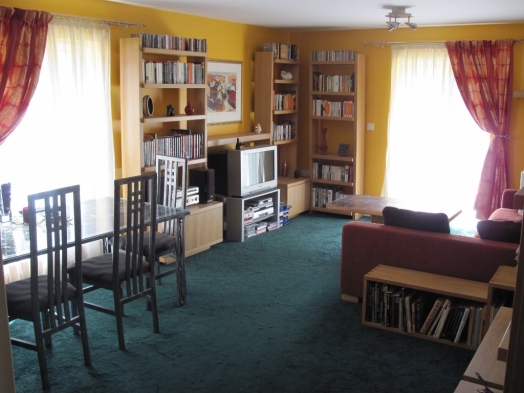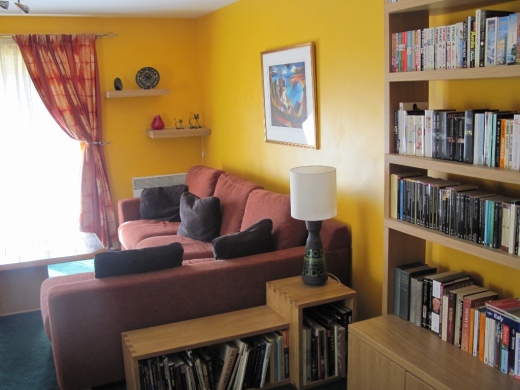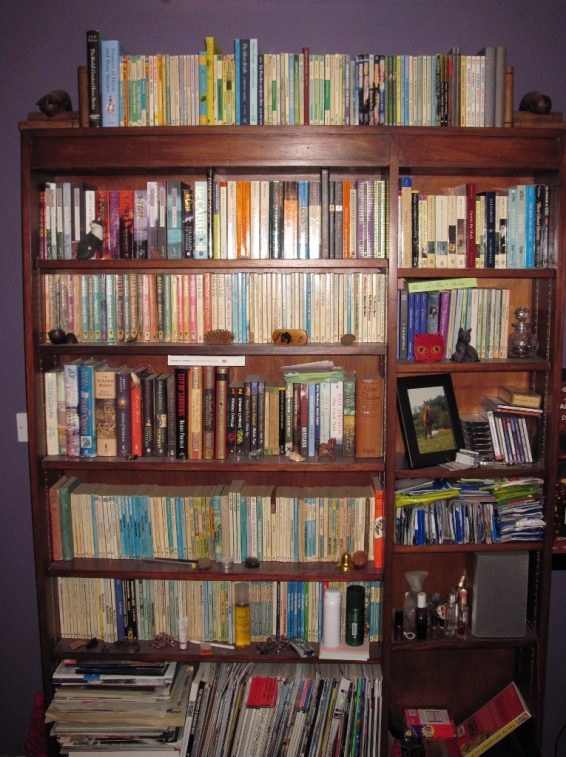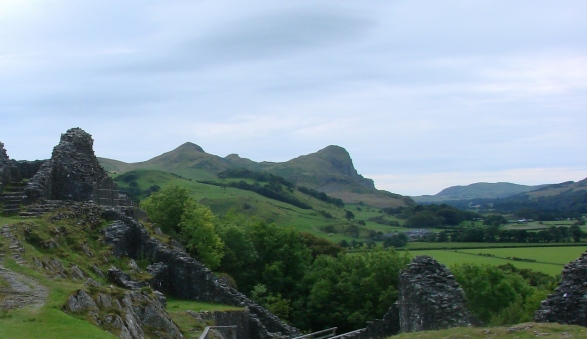Can you love books too much? For me, a large part of the pleasure when reading a book is deciding where it will go on my bookcase when it is finished. I love blogs or twitter chats about book shelves and how they are arranged, pictures of libraries are pure book porn for me and I often fall asleep at night imagining redesigning the entire house around books.

From the number of posts I’ve seen along these lines I am obviously not alone, but of course I’m a reader and a writer and the people I follow are too; or they are editors, agents, publishers – book lovers. But what about other people in our lives? Even if they don’t introduce themselves with; “Hello, I’m a reader,” don’t they like books too? I started wondering this a few weeks ago when I was writing about how I read and I realised that in almost all the houses I have visited for the first time in the last 6 years, I haven’t seen a single book in a living room.
There could be many reasons for this. For a start I’m talking about less than a dozen houses – I’m not a madly sociable person. The people I have visited have often been because of children’s parties or looking after a neighbours pets, it may well be that many of my friends have houses bursting with books. But it has still struck me each time I see a room with not a single book, either laid aside mid-read, or proudly on display.
I know ebooks are replacing the need for books on shelves, and de-cluttering is very much in fashion now. But even if people are reading on tablets and pads, where are all their books from just a few years ago before ereaders? I had friends years ago who gave many books away to charity shops after reading due to a lack of space, but they always replaced them at the same time with more second hand books to read. Are books considered old fashioned? Ugly? Bragging? I cannot imagine not having my collections all around me, but as I have said before, I am a slow reader for whom each book represent a microcosm of the person I was when I read it, where I was, how the book made me feel – I am bombarded with memories when I pick up a loved read, and the story itself isn’t often the first thing I think of when I feel the physical book in my hands again.

I would never judge anyone on the books they have on display – well I would try not to. But these days it’s more the utter lack of books that surprises me (and which I also try not to judge). Maybe it is to do with the age I now am and that the homes I visit are all of busy working families. When I was a student or single (ok, I lived in Oxford but I refuse to believe only University towns have people happy to display books so prominently – having said that, I did used to love walking home and peering into lit rooms, so many were lined with books in a way that I haven’t seen anywhere in the countryside, but I think a lot of that is architecture as much as the occupier’s choice. The classic town houses of Oxford and other cities and towns are designed with nooks and alcoves for book shelves, even if you don’t put books on them. The countryside homes built with agriculture or industry in mind tend to have more utilitarian features (I’m aware this is a sweeping generalisation but so many homes have been made in converted barns and former farm or industrial buildings and they are huge or neatly uniform places, no recesses or niches and any book shelves often seem dwarfed by the size of the rooms.) Plasma screens are the dominant features and dvds or games are the only purchases on display, books are only to be found in children’s’ bedrooms it seems.
Were books on display a part of showing off in the 70s and 80s when I grew up and all the houses of my parent’s friend’s were full of books? Are they no longer seen as essential? Were they for show, or art back then? Or am I basing all this on a very small selection or homes (yes, this cannot be a statistically significant finding.)
I do unashamedly love books though, browsing shelves whether in a library, a book shop or someone’s house – and I almost always ask permission before approaching someone’s shelves (or waited till they had left in the days when I babysat in other people’s homes.) Having just written that as if it were normal I think I have answered my initial question – it is possible for me to love, or revere, books too much.
However, even now, when I finish a book I take a lot of pleasure in working out where on my shelves it will go. My bookcases are roughly arranged with absolute favourites at top left and on around the room in decreasing satisfaction. If I read a book by an already admired author and it disappoints, it can mean the author’s entire oeuvre gets moved down – or up of course if an author surprises me.

The pictures I have posted here are all from my flat in Oxford. It was a bare concrete place when I moved in and along with a budget for a washing machine, fridge-freezer, bed, sofa, carpet (yes, I did choose that very dark green one in the photos, I loved it, everyone else who ever visited commented on it and at least two people offered to mow it for me) I also had money put aside for bookcases to create the effect in the first picture. It gave the room a focus and features, yes the tv was prominent, and the hi fi, but for me it was all about the books. I loved the fact I had enough space to break up the shelves so some just had ornaments on them. That last post is the bookcase I had in my bedroom where I could lie back on a lazy weekend morning as I drank a pot of tea and wondered if the book I was currently reading would make it into that room with my absolute favourite books (although I had forgotten until I looked at the picture just how many of the shelves contained pony books!) I feel as if I haven’t read nearly as much as I would like to in the 6 years since I took these photos just before the flat was sold, but comparing them with todays shelves my top selections have indeed been added to. I’m resolved to take photos of my collections at least once a year to monitor their change, and I shall never apologise for loving books too much.







